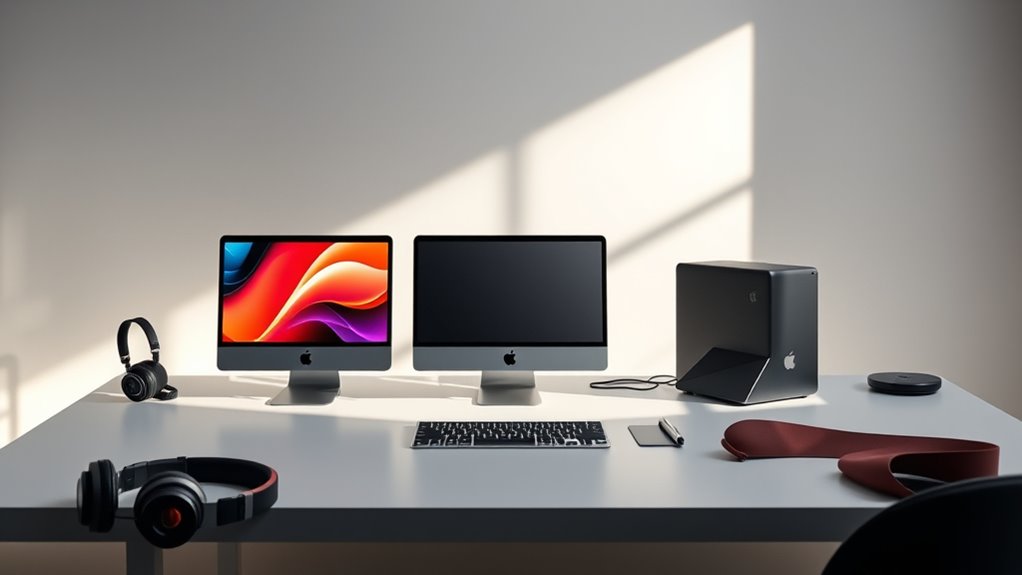For photography workflows in 2025, the top three Mac Studio models are the Mac Studio with M4 Pro, offering powerful multi-core performance and superior GPU acceleration, the standard Mac Studio with the M4 chip, which provides excellent processing capabilities and good value, and the compact Mac mini with M4 Pro, perfect for space-efficient setups with high-performance needs. These models deliver the power, speed, and precision needed for demanding editing tasks. If you keep exploring, you’ll uncover how to choose the best fit for your workflow.
Key Takeaways
- Models with M4 Pro or higher CPUs deliver superior processing power for handling large RAW files and complex edits.
- 2TB or 4TB SSD configurations ensure ample storage for high-resolution images and fast data access.
- Multiple Thunderbolt 4/5 ports and high-resolution display support optimize connectivity and editing precision.
- M4 Pro-based Mac Studio offers excellent hardware acceleration, reducing rendering times and improving workflow efficiency.
- Budget-conscious options with upgradeable external storage and peripherals provide flexibility for future growth.
Apple Mac mini Desktop Computer with M4 Chip (512GB SSD, 16GB RAM)
If you’re looking for a compact yet powerful desktop to handle photography workflows in 2025, the Apple Mac mini with M4 chip is an excellent choice. Its small footprint—just 5 by 5 inches and weighing only 1.5 pounds—fits easily next to your monitor. Equipped with a 10-core M4 processor, 16GB of unified memory, and a 512GB SSD, it offers lightning-fast performance for editing and multitasking. The Mac mini supports up to three high-resolution displays, runs quietly, and connects seamlessly via Wi-Fi 6E, Bluetooth 5.3, and multiple ports. It’s a sleek, durable, and efficient powerhouse ideal for creative professionals seeking space-saving power.
Best For: creative professionals, digital photographers, and video editors seeking a compact yet powerful desktop with seamless Apple ecosystem integration.
Pros:
- Compact, space-saving design that fits easily next to a monitor
- Fast performance with M4 chip, 16GB RAM, and 512GB SSD for multitasking and editing
- Supports multiple high-resolution displays up to 3 screens with excellent connectivity options
Cons:
- 512GB SSD may be limited for large media libraries, requiring external storage
- Initial setup steps, such as cable quality, are crucial for optimal performance
- Limited upgradeability post-purchase due to integrated hardware
Apple 2024 Mac mini Desktop Computer with M4 Pro Chip
The Apple 2024 Mac mini with the M4 Pro chip stands out as an ideal choice for photographers who need powerful performance in a compact form factor. Its small footprint—just 5×5 inches and 2 inches thick—fits easily next to monitors or in tight spaces. The M4 Pro chip delivers a 12-core CPU, 16-core GPU, and hardware-accelerated ray tracing, making it excellent for demanding editing tasks. With up to 64GB of RAM and configurable storage up to 8TB, it handles large files effortlessly. Multiple ports, including Thunderbolt 5 and HDMI, ensure seamless connectivity for peripherals and displays, making it a versatile, high-performance desktop for photography workflows.
Best For: photographers and creative professionals seeking a compact, high-performance desktop capable of handling demanding editing and rendering tasks with ease.
Pros:
- Compact size fits easily into tight or workspace-efficient environments
- Powerful M4 Pro chip with 12-core CPU and 16-core GPU for demanding creative workflows
- Extensive connectivity options including Thunderbolt 5, HDMI, and multiple USB-C ports
Cons:
- Limited upgradeability due to integrated hardware design
- Higher cost at maximum configurations compared to some competitors
- No dedicated GPU options beyond the integrated M4 Pro GPU
Apple Mac mini Desktop Computer with M4 Chip (2024)
Photographers seeking a powerful yet compact desktop often turn to the Apple Mac mini with the M4 chip because it delivers impressive performance in a tiny form factor. Measuring just five by five inches and weighing 1.5 pounds, it fits easily next to any monitor. Equipped with the M4 chip’s 10-core CPU, 10-core GPU, and 24GB of unified memory, it handles large files and multitasking effortlessly. Its hardware-accelerated media engine supports professional codecs like ProRes RAW and AV1 decoding. With multiple Thunderbolt 4 ports, HDMI, and support for up to three displays, it’s ideal for demanding photography workflows in a small, portable package.
Best For: creative professionals and power users seeking a compact, high-performance desktop with seamless Apple ecosystem integration.
Pros:
- Compact size with powerful M4 chip delivering excellent performance in a small form factor
- Supports up to three displays, including 6K, 8K, and 5K resolutions for extensive multitasking
- Seamless integration with macOS and Apple devices enhances productivity and workflow
Cons:
- Limited upgradability due to fixed hardware configurations
- No dedicated graphics card options; reliant on integrated GPU for performance
- Premium price point may be a consideration for budget-conscious users
Factors to Consider When Choosing a Mac Studio for Photography Workflows

When selecting a Mac Studio for photography work, we need to consider several key factors to guarantee it meets our needs. From processing power and storage options to display compatibility, each aspect impacts our workflow efficiency. Budget constraints and connectivity features also play an essential role in making the right choice.
Processing Power Needs
Processing power is a critical factor to contemplate when selecting a Mac Studio for photography workflows, as it directly impacts how efficiently large files and complex edits are handled. A high-performance CPU, like an M4 Pro or higher, can drastically cut down rendering times and boost editing speed. Multi-core processors allow us to multitask seamlessly, running editing software, backups, and other applications simultaneously without lag. Hardware acceleration features in top-tier models speed up encoding and exporting high-resolution images and videos. Ensuring sufficient processing capacity is essential for smooth performance during resource-intensive tasks, such as applying multiple filters, working with 3D elements, or managing large photo libraries. This means choosing a Mac Studio with the right CPU ensures a faster, more efficient workflow.
Storage Capacity Options
Choosing the right storage capacity for your Mac Studio is essential to keep your photography workflows smooth and efficient. High-resolution RAW images and large projects demand ample space, so opting for 2TB or 4TB SSD options is wise for photographers with extensive libraries. Larger storage reduces reliance on external drives, streamlining data management and speeding up workflows. Your storage choice should match the typical size of your project files; professionals often need 1TB or more to edit seamlessly. Consider future-proofing by selecting configurations that support storage upgrades or external drives, accommodating growing data needs. While higher capacities come with increased costs, they offer faster data access and improved performance, making them a valuable investment for demanding photography workflows.
Display Compatibility
Selecting the right display setup for your Mac Studio is essential to guarantee accurate color reproduction and efficient workflow. You’ll want a system that supports multiple high-resolution displays, such as 6K or 8K, over Thunderbolt or HDMI, to handle expansive workspaces. Verify that your Mac Studio is compatible with DisplayPort 2.1 or HDMI 2.1 standards for seamless connection to professional-grade monitors. The number and type of ports, including Thunderbolt 4 or 5 and USB-C, are critical for flexible display configurations. Additionally, ensure the graphics hardware can handle precise color calibration and support native protocols and resolutions necessary for photo editing and color grading. Proper display compatibility guarantees that your workflow remains accurate, efficient, and up to professional standards.
Connectivity Features
To guarantee smooth photography workflows on your Mac Studio, it’s vital to prioritize connectivity features that support your high-speed data transfer and peripheral needs. Make sure the model has ample ports, like multiple Thunderbolt 4 or USB-C connections, for quick transfer from cameras, external drives, and accessories. Look for HDMI or DisplayPort support capable of handling multiple high-resolution displays, essential for detailed editing. Confirm the presence of high-impedance headphone jacks and multichannel audio support for precise audio monitoring. Ethernet options, such as 10Gb Ethernet, enable fast transfer of large image files over local networks. Additionally, compatibility with external card readers and specialized accessories via USB-C or Thunderbolt ports streamlines your workflow, making your Mac Studio a versatile hub for all your photography needs.
Budget Constraints
Budget constraints play a significant role in determining which Mac Studio model best fits your photography workflow. Higher-spec models with more RAM, faster storage, or advanced GPUs often come with a hefty price tag, making them less accessible. Choosing a less expensive configuration might mean investing in external upgrades like SSDs or hubs, which adds to overall costs. Lower-tier models may lack essential ports or features needed for efficient editing, requiring additional accessories. Opting for a budget-friendly Mac Studio could also lead to compromised performance, especially when handling large RAW files or complex edits. Additionally, purchasing pre-owned or refurbished units might save money but could impact warranty coverage and support. Balancing your workflow needs with budget constraints is key to making an informed decision.
Future Expansion
When choosing a Mac Studio for photography workflows, considering future expansion options is crucial to guarantee your setup remains flexible as your needs grow. Make sure the device has enough Thunderbolt 4 or USB-C ports to connect multiple external storage devices, monitors, and peripherals essential for editing and managing large files. Verify support for high-speed Ethernet, like 10Gb Ethernet, to enable quick transfers from networked storage solutions. It’s also wise to select models with higher RAM capacities, such as 48GB or 64GB, to handle large RAW files and demanding software simultaneously. Furthermore, confirm compatibility with multiple high-resolution displays, including 6K or 8K monitors, for detailed editing. Finally, consider internal storage options that pair well with external SSDs or cloud services, allowing scalable, flexible storage as your photo library expands.
Software Optimization
Since software optimization directly impacts how effectively your photo editing applications utilize the Mac Studio’s hardware, it’s essential to choose software that is well-optimized for high-performance workflows. Optimized software ensures smooth operation by fully leveraging the Mac Studio’s powerful CPU, GPU, and memory. This reduces rendering times and enhances real-time editing, especially with high-resolution images. Compatibility with hardware-accelerated features like GPU-based filters and effects further boosts efficiency. Well-optimized applications minimize lag, crashes, and instability, creating a more reliable editing environment. Regular updates from developers also play a critical role, as they refine performance and ensure your software takes full advantage of the hardware advancements. Prioritizing software optimization helps you maximize your Mac Studio’s potential for seamless, efficient photography workflows.
Frequently Asked Questions
How Does the M4 Pro Chip Impact Photo Editing Speeds?
The M4 Pro chip considerably boosts our photo editing speeds by providing faster processing and more efficient multitasking. We notice quicker rendering times, smoother adjustments, and seamless handling of large RAW files. Its advanced GPU accelerates our workflows, allowing us to work more efficiently without lag or delays. Overall, the M4 Pro makes editing more responsive, enabling us to focus on creativity rather than technical limitations.
What Peripherals Are Recommended for Optimal Mac Studio Performance?
We recommend high-quality peripherals like calibrated monitors for accurate color editing, a fast external SSD for quick file transfers, and a reliable mouse and keyboard for comfort. Consider a dedicated graphics tablet for precision retouching and a good set of speakers or headphones for detailed audio work. Connecting via Thunderbolt or USB-C guarantees peak speed and performance, helping you maximize your Mac Studio’s power for seamless, efficient photo workflows.
Can Mac Mini Models Handle Large RAW Image Files Efficiently?
Absolutely, Mac mini models can handle large raw image files, but it depends on the specs. If we go in with a higher-end configuration, especially with more RAM and a faster processor, it’s like putting all your ducks in a row. While they’re not quite as powerful as Mac Studios, they’re still capable of managing hefty files efficiently, making them a solid choice for budget-conscious photographers.
How Does Storage Expansion Work on Mac Studio Models?
Storage expansion on Mac Studio models is straightforward. We can configure them with larger SSD options during purchase, and they also support external drives through Thunderbolt or USB-C ports for added capacity. This flexibility lets us keep large raw image files accessible without sacrificing speed. Plus, the fast SSDs ensure quick data transfer, helping us stay efficient during intense editing sessions.
Are There Specific Display Requirements for Professional Photography Workflows?
Did you know that professional photographers often prefer displays with at least 100% sRGB coverage? For your workflows, we recommend a display with high color accuracy, like those supporting P3 wide color gamuts, to guarantee true-to-life images. A calibrated monitor with 10-bit color depth helps you make precise edits. We suggest investing in a display that offers excellent resolution and color consistency, essential for delivering professional-quality results.
Conclusion
As we stand on the edge of innovation, each Mac Studio model promises a leap in our photography workflows. Imagine the perfect blend of power, speed, and precision fueling our creative visions—waiting just beyond our reach. The right choice could transform how we work, opening new possibilities and pushing boundaries we’ve only dreamed of. Are you ready to take that leap and elevate your craft to extraordinary heights? The future of photography awaits.











